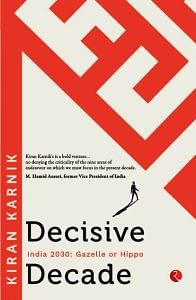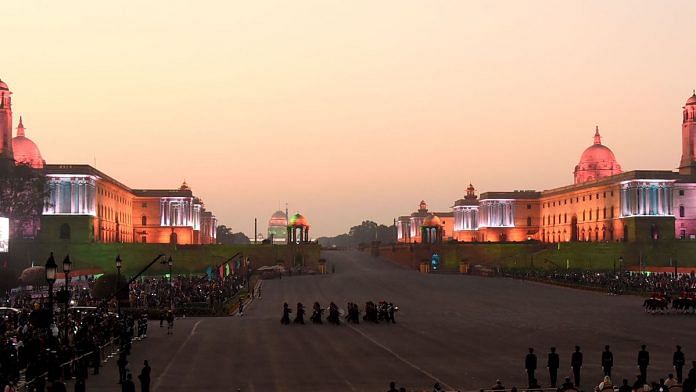One thing about the future was certain, at least till recently: that it would arrive. However, a worldwide nuclear war could kill most of us and make the planet uninhabitable for humans. Alternatively, climate change and runaway global warming could lead to a similar result: an earth on which our species may not survive. In both cases, there would hardly be a future. This book does not foresee such apocalypses, and believes that humans are wise enough to avoid such an end, even if we sometimes seem to be at the very edge of this cliff. It looks at the future with cautious optimism and hope.
Ten years in the life of a nation is but a blink of an eye. For a country like India, with a history that stretches back some 5,000 years, it is a negligible period. Can one really expect to see any discernible change in such a short period of one decade? On the other hand, the accelerating pace of change means that time scales have been telescoped. Lenin said, ‘There are decades where nothing happens; and there are weeks where decades happen’. Technological advancement seems to have brought us to the stage where decades happen in weeks; this, and the speed of technology’s penetration into society, means that the extent and pace of change are both high. As technology becomes a part of almost all that we do, its influence and effect are immense. It has a deep and wide impact on our work, leisure and behaviour. While effects on individual behaviour and societal norms are typically slow and long-drawn-out processes, the timeline on this too is changing. The velocity of technology’s spread and its ubiquity are shrinking the time required for social change. It is in this context that there are clear possibilities of seeing tangible and substantial changes over the period of a decade. This, then, is the premise of what follows: that there will be considerable and visible change in many aspects of India between 2020 and 2030.
The century began well, with the first ten years recording unprecedented growth rates in the economy. Millions were lifted out of poverty, and the economy grew at an average of 7.36 per cent a year from 2003 to 2010. If the exceptional year of global slowdown (2008) is excluded, the average growth rate increases to 7.97 per cent. India was also unique in terms of successfully weathering the global economic crisis of 2008. This added to its international stature. On the political front, relations with China were stable, with booming trade overriding past suspicions; the US was a strategic partner; our long-time friendship with Russia continued (even if with lesser intensity); Pakistan was getting increasingly isolated diplomatically, with no takers for its propaganda against India and our relationship with other neighbours was cordial. Within the country, there was comparative harmony. India’s star was very much on the ascendant.
Also read: Modi’s India has lost hope. It needs a JP for the 21st century
in the 2019 elections (bringing it back to power with even more seats in Parliament), but have not done any good for India in strategic terms. The 2020 border fracas with China took our relationship back by many decades, and is going to require a big increase in military spending (at the cost of pressing social and infrastructure needs). The economic and livelihoods situation suffered a further setback from March 2020 due to the COVID pandemic and consequent lockdowns. In summary, it seems that the years from around 2011–12 may be considered India’s lost decade.
The 2020s provide an opportunity to once again emulate the period from around 2000 to 2012. Will we choose the correct path at the crossroads? India can either sink further into a morass of disharmony, social unrest, low economic growth and poverty, or it can begin to build itself up. If the nation can focus on key areas that affect its future (and not on our ‘glorious past’ or the ‘70 years of misrule’), we have an opportunity to not only take the country forward in a big way, but also to strengthen the base for crafting a glorious future.
In looking ahead, one approach could be to identify and call out the changes that may be seen in a decade, as compared to 2020. This would, therefore, look at outcomes: the actual impact on our work, leisure, life and the environment around us. It would, in a way, present a scenario of life in 2030. Another approach is to look at a step preceding the outcomes. It would seek to identify key factors that will drive the major changes that we may see in 2030 and track how each of these would evolve over the course of the decade from 2020 to 2030. This requires, first, analysis to determine the factors that would have the maximum influence on individuals and society as the country goes towards 2030, and then prediction of what changes might be seen in each of them between now and 2030.
The hope (indeed, the expectation) was that this would be India’s century. Some even felt that it marked the beginning of an Indian millennium. However, from around 2012, things started going downhill. Accusations of corruption and scams bedevilled the government, seemingly paralysing policymaking and affecting governance. This, and some retrograde (and retrospective) tax laws in the Union Budget of 2012–13, put the brakes on economic growth, worsening the impact of a general global economic slowdown. The change of government in 2014 led to initial optimism, but soon the downward trajectory resumed (visibly so, after demonetization in November 2016); if anything, the increasing communal disharmony and the focus on divisive cultural and political issues created greater problems. ‘Muscular’ policies with regard to Pakistan and in Kashmir may have paid off for the Bharatiya Janata Party (BJP) in the 2019 elections (bringing it back to power with even more seats in Parliament), but have not done any good for India in strategic terms. The 2020 border fracas with China took our relationship back by many decades, and is going to require a big increase in military spending (at the cost of pressing social and infrastructure needs). The economic and livelihoods situation suffered a further setback from March 2020 due to the COVID pandemic and consequent lockdowns. In summary, it seems that the years from around 2011–12 may be considered India’s lost decade.
Also read: Why Bangladesh – not India or Pakistan – is destined to be the economic star of South Asia
The 2020s provide an opportunity to once again emulate the period from around 2000 to 2012. Will we choose the correct path at the crossroads? India can either sink further into a morass of disharmony, social unrest, low economic growth and poverty, or it can begin to build itself up. If the nation can focus on key areas that affect its future (and not on our ‘glorious past’ or the ‘70 years of misrule’), we have an opportunity to not only take the country forward in a big way, but also to strengthen the base for crafting a glorious future.
In looking ahead, one approach could be to identify and call out the changes that may be seen in a decade, as compared to 2020. This would, therefore, look at outcomes: the actual impact on our work, leisure, life and the environment around us. It would, in a way, present a scenario of life in 2030. Another approach is to look at a step preceding the outcomes. It would seek to identify key factors that will drive the major changes that we may see in 2030 and track how each of these would evolve over the course of the decade from 2020 to 2030. This requires, first, analysis to determine the factors that would have the maximum influence on individuals and society as the country goes towards 2030, and then prediction of what changes might be seen in each of them between now and 2030.
This decade, the 2020s, will set the course for India, just as the ten years from 1950 laid out the path for the country in the 20th century, through the enunciation of values and the creation of key institutions. It is the make-or-break decade for India, a time for transformation—indeed, the decisive decade. Globally, its size, leadership and ‘positioning’ as being independent from the two major power blocks, propelled it to leadership of the ‘non-aligned’ countries. This made India a powerful moral force in the geopolitical world. The coming years from 2020 to 2030 are when we will go through a reiteration or a re-set of many vital parameters. With changing power equations and the virtual demise of non-alignment, the country will have to reposition itself. Various options exist, but we pick two. To summarize them through an analogy, by 2030 India could be viewed as a gazelle: sleek, agile, fast-moving and likeable. Or it could end up like a hippopotamus: large, but bulky, slow-moving and—worse—aggressive. What will we be?
 This excerpt from Kiran Karnik’s ‘Decisive Decade’ has been published with permission from Rupa Publications.
This excerpt from Kiran Karnik’s ‘Decisive Decade’ has been published with permission from Rupa Publications.



